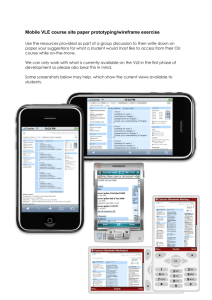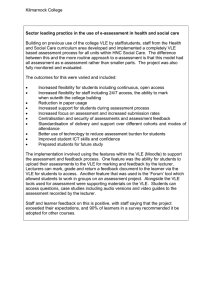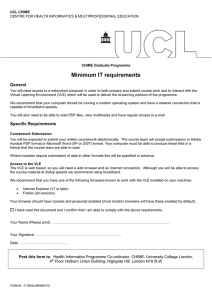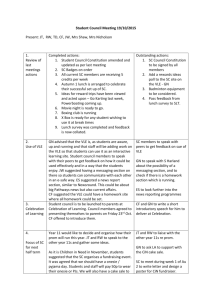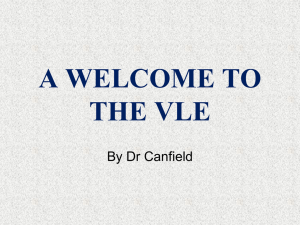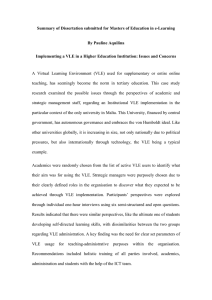An Evaluation of Virtual Learning Environment Abdirahman Abdulahi Ahmed
advertisement
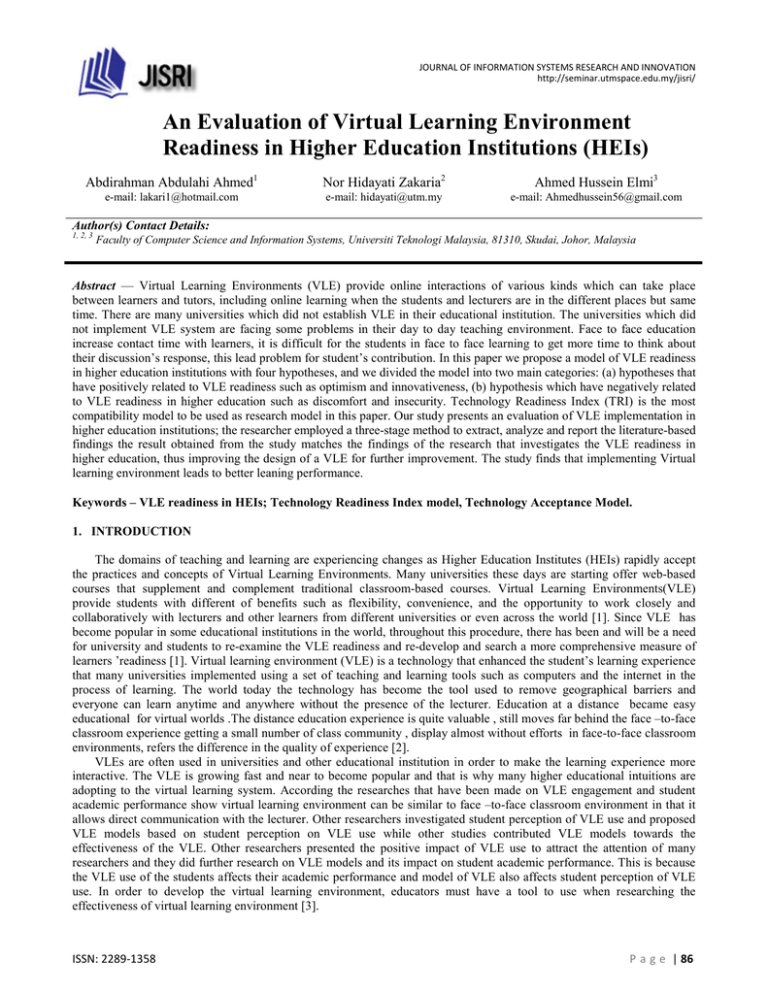
JOURNAL OF INFORMATION SYSTEMS RESEARCH AND INNOVATION http://seminar.utmspace.edu.my/jisri/ An Evaluation of Virtual Learning Environment Readiness in Higher Education Institutions (HEIs) Abdirahman Abdulahi Ahmed1 Nor Hidayati Zakaria2 Ahmed Hussein Elmi3 e-mail: lakari1@hotmail.com e-mail: hidayati@utm.my e-mail: Ahmedhussein56@gmail.com Author(s) Contact Details: 1, 2, 3 Faculty of Computer Science and Information Systems, Universiti Teknologi Malaysia, 81310, Skudai, Johor, Malaysia Abstract — Virtual Learning Environments (VLE) provide online interactions of various kinds which can take place between learners and tutors, including online learning when the students and lecturers are in the different places but same time. There are many universities which did not establish VLE in their educational institution. The universities which did not implement VLE system are facing some problems in their day to day teaching environment. Face to face education increase contact time with learners, it is difficult for the students in face to face learning to get more time to think about their discussion’s response, this lead problem for student’s contribution. In this paper we propose a model of VLE readiness in higher education institutions with four hypotheses, and we divided the model into two main categories: (a) hypotheses that have positively related to VLE readiness such as optimism and innovativeness, (b) hypothesis which have negatively related to VLE readiness in higher education such as discomfort and insecurity. Technology Readiness Index (TRI) is the most compatibility model to be used as research model in this paper. Our study presents an evaluation of VLE implementation in higher education institutions; the researcher employed a three-stage method to extract, analyze and report the literature-based findings the result obtained from the study matches the findings of the research that investigates the VLE readiness in higher education, thus improving the design of a VLE for further improvement. The study finds that implementing Virtual learning environment leads to better leaning performance. Keywords – VLE readiness in HEIs; Technology Readiness Index model, Technology Acceptance Model. 1. INTRODUCTION The domains of teaching and learning are experiencing changes as Higher Education Institutes (HEIs) rapidly accept the practices and concepts of Virtual Learning Environments. Many universities these days are starting offer web-based courses that supplement and complement traditional classroom-based courses. Virtual Learning Environments(VLE) provide students with different of benefits such as flexibility, convenience, and the opportunity to work closely and collaboratively with lecturers and other learners from different universities or even across the world [1]. Since VLE has become popular in some educational institutions in the world, throughout this procedure, there has been and will be a need for university and students to re-examine the VLE readiness and re-develop and search a more comprehensive measure of learners ’readiness [1]. Virtual learning environment (VLE) is a technology that enhanced the student’s learning experience that many universities implemented using a set of teaching and learning tools such as computers and the internet in the process of learning. The world today the technology has become the tool used to remove geographical barriers and everyone can learn anytime and anywhere without the presence of the lecturer. Education at a distance became easy educational for virtual worlds .The distance education experience is quite valuable , still moves far behind the face –to-face classroom experience getting a small number of class community , display almost without efforts in face-to-face classroom environments, refers the difference in the quality of experience [2]. VLEs are often used in universities and other educational institution in order to make the learning experience more interactive. The VLE is growing fast and near to become popular and that is why many higher educational intuitions are adopting to the virtual learning system. According the researches that have been made on VLE engagement and student academic performance show virtual learning environment can be similar to face –to-face classroom environment in that it allows direct communication with the lecturer. Other researchers investigated student perception of VLE use and proposed VLE models based on student perception on VLE use while other studies contributed VLE models towards the effectiveness of the VLE. Other researchers presented the positive impact of VLE use to attract the attention of many researchers and they did further research on VLE models and its impact on student academic performance. This is because the VLE use of the students affects their academic performance and model of VLE also affects student perception of VLE use. In order to develop the virtual learning environment, educators must have a tool to use when researching the effectiveness of virtual learning environment [3]. ISSN: 2289-1358 P a g e | 86 JOURNAL OF INFORMATION SYSTEMS RESEARCH AND INNOVATION http://seminar.utmspace.edu.my/jisri/ This paper presents an evaluation of the implantation of VLE in higher education intuitions, and sets out to comprehend technology readiness in this context. The aim of this paper is to discuss the factors that impact VLE readiness in higher education, and also to propose VLE readiness model. 2. RELATED WORK A. Virtual Learning Environment vs. Traditional Learning Traditional learning and virtual learning environment have notably converged in the past decade. Some researchers categorize traditional learning as teacher cantered instructions of synchronous and scheduled group, classroom availability is necessary, while virtual learning environment is student centered and available anywhere, and any time [4]. There is no opinion that support the best way of learning is traditional and other models are not good for learning purpose and less efficient, but research shows that e-learning is an effective way of learning as traditional education , it is not replacement of lectures but it enhance the learning process [5]. VLE provide searchable study guides and lecture materials, ComputerAssisted Learning (CAL) materials, discussion boards (for mediating online and for general communication learning and teaching), (streamed) video, and assessment as learning and teaching resource. It may also provide logical and administrative systems such as student recruitment (like online registration and payment of fees), student records, interactive and personalized scheduling and timetabling and assessment feedback and results [6]. The following table summarizes several opinions regarding the comparison between traditional learning and virtual learning environment: TABLE 1: Comparison between Traditional Learning and Virtual Learning environment [7] Considering Factors Traditional learning Virtual learning environment Resources Resources available within a library or information centre unit. More expensive because you may look for it a lot of time. Classroom discussion The teacher usually talks more than the students Campus-based courses require that you attend class a certain number of times every week, at specific times Institute is driven time and learning schedule Learning materials and resources available within the system are less expensive, partly because you don’t have to pay for facilities such as gyms, libraries, dining halls, and residence halls. The student talk at least as much as or more than the teacher Every online class is run differently, but in most cases, it is much easier to schedule your classes around the rest of your day when you go to college virtually User driven time and learning schedule The studying is based on various sources of information such as web data banks Scheduling Course matter The teacher conducts the lessons according to the study program and existing curriculum Learning process The learning participating class Most of the learning process takes in groups or by the individual student Location of learning In the classroom, the learning takes place within the school and classroom Motivation The student motivation is low , and subject matter is distant from them Interaction Spontaneous , student can interact with other students Discussion forum, video conference , chat rooms, the learning takes place with no fixed location The student motivation is high , due to the involvement in matters that are closer to them and to the use of technology Structured, student can interact with other students ISSN: 2289-1358 conducts whole P a g e | 87 JOURNAL OF INFORMATION SYSTEMS RESEARCH AND INNOVATION http://seminar.utmspace.edu.my/jisri/ B. Virtual Learning Environment in Higher Education The virtual learning environment in higher education has become significant growth over the last years. The use of the VLE in higher education may face challenges such as providing effective educational material within the VLE, and teaching way and the development of suitable pedagogy. Since VLE has positive change in the educating experience, there are many universities implementing this method of teaching while other academic institutions don’t use this kind of teaching. To create a working virtual learning environment, it is important to consider some key areas such as mandates of the higher educational institutions pertaining to the educational delivery methods, teaching design and requirements, the functional needs of the course delivery, and technical skills and needs of the various populations of the students and academics [8]. Some researchers don’t believe that the students-centered teaching approaches encourage learners to adopt a good quality approach to learning. There are pressures on the teachers to use a specific approach in their teaching. The lecturers who felt that they had more control over their teaching were to adopt learners focused approaches. Teachers’ beliefs about teaching and learning and how to use the most effective learning environment are elements to improving student learning [9]. The use of the VLE within university course is outlined. The virtual learning environment was provided to the learners as an addition to the face-to-face lectures of the higher education course. The traditional university lecture was combined with and internet base test module. The aim of the VLE was to enhance students’ learning process. The students who use the virtual learning environment are in two different parts: some students did not spend much time using the virtual learning environment this is one hand the other part there are students who did not spend much time in education but use the VLE extensively [10]. Some researchers argued that some students in universities who used the VLE did not meet the original internet to offer the students with a tool to support the way they are learning during the semester. The students who use the VLE as the way of learning want to refine their knowledge and establish deeper understanding and more general view of the topic after having acquired the key terms and basic concept through reading the textbook and attending course lecture this is one strategy. The second strategy is the students’ using of the VLE before the exam to get as much knowledge as possible in the shortest period of time [10]. The VLE and higher education are highly relevant to decision makers and professionals that involved in the design, implementation and evaluation of online learning to serve the higher education community. There are two main considerations which were driven on the impact of the VLE on teaching and how the lecturers respond to the introduction of virtual learning environments. The first stage is the evidence of the influence of how the staff uses technology in learners’ use and the benefits the latter might draw from the technology. Successful integration of technology in the student’s course depends not only availability and access but on how lectures use an embrace computer. Second stage is an understanding of the influence of new technologies on teachers and lecturers was sought in order to inform institutional approaches to lead to the identification and to staff development of models of good practice [11]. C. Virtual Learning Environment Technology: There are a lot of open source applications that are used to implement VLE in higher educational institutions. These technologies are designed for teaching and learning and are customizable. Most of the universities around the world prefer using these applications to minimize the cost they are supposed to develop their own Virtual Learning Environment system or platform. Many organizations, companies and educational institutions are attempting to integrate the educational systems of the asynchronous using VLE. The VLE is the delivery of learning using electronic mediation which is the bridge between the lectures and students when they are in the different places but same time. Voice , video data , and print through such formats as radio , television , web based programming , and streaming audio and video are part of mediation , as well as variety of recording technologies [4] . Virtual Learning Environments can integrate social software such as Rich Site Summary (RSS) , wikis, blogs or other public or personal learning environment There are minimum requirements that VLE should meet, the tools available to the teachers allow him to present a course with an easy and attractive to navigate manner. These tools will make it valuable to be used by the students for the successful implementation of the learning process. Instructional Management Systems (IMS) and Sharable Content Object Reference Model (SCORM) standards and specifications are indispensable in synchronous Virtual Learning Environments. VLE constant changes and revisions in Elearning have created a little confusion in the field of terminology, it has been described as; Course Management System (Corms), Learning Management System (LMS), Learning Support System (LSS), Learning Content Management System (LCMS), Managed Learning Environment (MLE), Learning Platform, and Online Learning Centre (OLC) [12]. Some examples of well-known of the above categories are LAMS, Model, Iliac, Sakai, WebTV, Tutor, Blackboard and Caroline [13] . ISSN: 2289-1358 P a g e | 88 JOURNAL OF INFORMATION SYSTEMS RESEARCH AND INNOVATION http://seminar.utmspace.edu.my/jisri/ D. VLE and Pedagogy VLE can be educational approach that will be used and having a clear view of how using a virtual learning environment satisfies the educational aims and goals of the institutional strategy. For example, the company can identify who are their customers, examine potential systems against these requirements, and ability to become part of a full Managed Learning Environment [14] .The VLE should act as focus for the learning activities of the students and facilitation of those learning facilities along with the provision of resources and contents. The successful use of VLE is dependent on the quality of course design and pedagogy. The unsuccessful use of VLE is due to preassumption that the computer can do the work of a lecturer resulting in poor engagement of passive learning and students [14]. There are several of pedagogical models, examples are: open resource based learning (using simple web technology), e-learning platform, collaborative learning [15]. The ICT and distance learning have created a new teaching pedagogy and a new business, lack of ability of teachers to develop the needed pedagogy and to develop skills, and to adopt a positive attitude are important issues affecting the creation of VLE’ communities. There is a relation between personal experience and pedagogy and distance learning. For example, when a lecturer is somewhat reluctant to use the technology or views it in a negative way, pedagogy may suffer. Another factor in the personal development of technological pedagogy is a method of introducing computers to faculty [16]. There is different between pedagogy required in corporate distance learning education and that in academic settings. Traditional face-to-face education mostly focused on individuals with the education mission to achieve productive output. Business is focused on with the educational mission of educating individuals, as a means to the corporate end of profitability [16]. The educational aims of higher education, according to constructive pedagogy may be divided into the parties: 1) Knowledge and skills acquisition, 2) Socialization, 3) Development of intentional learning, a way of learning in which learning it is the goal and the individual becomes a self-organized educator reflective practice, capable of critical thinking. Implementation of immersive learning centered educational environment is based on the constructivist pedagogy [17]. 3. METHODOLOGY This paper is specifically devoted to search and review the literature on how VLE can be implemented in higher education institutions. The researchers employed a three-stage method to extract, analyze and report the literature-based findings. The first stage involved identifying the articles to be included in this review. The second stage involved designing and executing a detailed protocol that prescribed how to capture and analyze the data. The third stage entailed synthesizing the analyzed details and deriving the research findings. In identifying the articles to be included in this review, leading VLE readiness in higher education journals and academic conferences were considered. The total of papers that researcher reviewed were 20 papers. Paper extraction occurred in two steps. In the first step, the focus was on extracting papers that include VLE and its’ models. In the second step, the focus was extracting papers that address VLE in higher education. The protocol that researchers followed was to create a folder for papers and then sorting topics as similarities, this made easy to find important data about VLE as well extracting different ideas from different authors. Finally the researchers succeeded to compare several models of technology such as TAM and TRI and this led to construct and propose a research model as well as to elicit literature review of the research. After comparing different models of VLE, the researcher found that some important factors of VLE readiness are not included in these models. So the proposed model is considered complementary of the VLE readiness models. 4. THEORIES IN VIRTUAL LEARNING ENVIRONMENT VLE can be implemented in many ways depend on the situation and requirement of the institutions. Many universities offer web based courses distributed by the VLE. A common theoretical framework for the implementation VLE is the pedagogical perspective of instructional design. Students can use technology to get class information or notes, take assessments, and can communicate everywhere they are, and whenever the need arises. In order to use VLE, you must actually be used the technology, and the use full way of using of ICTs in delivering Virtual Learning Environment based on components of the course which is important to the success and students' reception of VLEs system. There are several theories that can be an empirical support and considerable concerns in this study. ISSN: 2289-1358 P a g e | 89 JOURNAL OF INFORMATION SYSTEMS RESEARCH AND INNOVATION http://seminar.utmspace.edu.my/jisri/ A. Technology Acceptance Model (TAM) TAM was developed and empirically tested by Davis [18]. TAM uses multiple item scales to operationalize Behavioral Intension, Perceived Usefulness, and Perceived Ease of Use. Perceived Usefulness was defined as the degree to which person believes that using a particular system would enhance his or her job performance. Perceived Ease of Use referred to the degree to which a person believes that using a particular system would be free of effort. TAM was originated from the Theory of Reasoned Action (TRA); it was designed to understand the causal linking external variables to its user acceptance and actual use in the workplace. A system high in perceived usefulness, was one for which a user believes in the existence of a positive user-performance relationship. An application perceived is easier to use than another was more likely to be accepted by the user. These two specific beliefs perceived usefulness and ease of use have led to confidence in the instrument for studying the acceptance of Virtual Learning Environment [18]. Perceived usefulness Intention to use Actual use perceivd easiness FIGURE 1: Technology Acceptance Model (TAM) [18]. B. Technology Readiness Index (TRI) Model There are differences between the peoples’ disposition and ideas towards using technology. Technology readiness index (TRI) is a theory that relates to technology implementation in general. The behavior differs among people; therefore the peoples’ beliefs about different aspect of technology differ. Some people may think technology is an important thing in their life and it is helpful where other people may think the technology brought heavy problems in the world. The relative strength of each character indicates the people’s openness to technology. Technology readiness theory thus reflects a group of beliefs and ideas about technology; it is not an indicator of people’s competence in using it. Technology readiness theory defines four parts of users separated by their personality behavior and trait with two factors being inhibitors of new technology use and other two being motivators; the characteristics are: • Optimism: it is a positive view of technology, and a belief and perception that if offers people flexibility , increased control, and efficiency in their lives due to technology • Innovativeness : which means a tendency to be the first using a new technology and thought leader , technology pioneer • Discomfort : which means perceived lack of control over technology and having a sense of being overwhelmed • Insecurity: which means distrust of theology for privacy and security reason, and skepticism about the technology's ability to work properly [19]. People who have high levels of TRI score high on innovativeness and optimism. They feel happy and comfortable using technology and only need to call for small proof of its quality and performance. Where people who have lower levels of TRI are more critical, they feel uncomfortable with the technologies and as for help more often [20]. ISSN: 2289-1358 P a g e | 90 JOURNAL OF INFORMATION SYSTEMS RESEARCH AND INNOVATION http://seminar.utmspace.edu.my/jisri/ Contributors Innovativeness Optimism Technology Readiness Index Insecurity Discomfort Inhibitors FIGURE 2: Technology Readiness Index (TRI) [21]. 5. PROPOSED MODEL The researcher developed conceptual model which has been adopted form Technology Readiness Index Model (TRI). There are many models that mostly used to measure user readiness , the researcher used Technology readiness index .TRI was developed by Parasuraman to measure a multiple scale for accepting new technology or denying .This model refers to people’s tendency to use new technologies to achieve specific purpose .This model has been selected based on compatibility of this research with other studies which use the same model .TRI is the most compatibility model to be used as research model for this study. The first two components of this model are optimism and innovativeness were categorized as contributors these two components increase consumers’ TRI. The other two components in this model are insecurity and discomfort, they are inhibitors, and they may suppress TRI. This model is able to distinguish between the people who want to use the high technology service and who do not. This model also can identify a group of users who their beliefs of insecurity and discomfort is possible to be very significant. This model connects well with people who own the technology based on service and product (who have a significantly higher TRI score) and with people’s use of this technology. This model can test whether the VLE is ready to implement or not. Therefore Technology readiness index is chosen to be research mode of this study. A. Optimism It is a positive view of technology, a belief and perception that if offers people flexibility, increased control, and efficiency in their lives due to technology. The researcher wants to get information about how the students interesting VLE implementation in higher education. This factor indicates the positive view in VLE readiness in higher education. This will display how optimism has positive significance on the readiness of students to use Virtual learning environment. We hypothesize that: Hypothesis 1: Optimism has a positive significant effect on the VLE readiness in higher education B. Innovativeness There are many universities around the world that implemented virtual learning environment as a tool of their learning some of these universities use the VLE as partial of their way of learning, they use the VLE in some fields and programs and did not implement it in all their departments. Innovativeness means a tendency to be the first using a new technology and thought leader, technology pioneer. In this section the researcher investigates the students' idea towards implementing a VLE as a tool of learning in higher education institutions, instead of face-to-face learning. We hypothesize that: Hypothesis 2 Innovativeness has a positive significant effect on the VLE readiness in higher education. ISSN: 2289-1358 P a g e | 91 JOURNAL OF INFORMATION SYSTEMS RESEARCH AND INNOVATION http://seminar.utmspace.edu.my/jisri/ C. Discomfort In this factor, the researcher investigates the students' negative beliefs about technology because some people are not feeling comfortable with the technology, and they think technology may Cause huge problems in their life, some people think the technology needs a lot of time and human and expending huge of money so its losing time, Discomfort means perceived lack of control over technology and having a sense of being overwhelmed. We hypothesize that: Hypothesis 3: Discomfort has negative significant influence on the VLE readiness in higher education. D. Insecurity Some people are distrusting technology for privacy and security reason and harbour skepticism about the technology's ability to work properly, because they think their information through the web is not safe, it may face attacks from hackers, so that essential data that they want to get over the internet may be found by other people. Feeling confident for doing thing is an important thing there some students may not feel confident to do their learning via VLE because they think it is a place that they can only be reached by online. We hypothesize that: Hypothesis 4 Insecurity has negative significant effect on the VLE readiness in higher education. . Optimisim H1 (+) H2 (+) Innovativeness H3 (-) VLE Readiness in Higher Education Discomfort H4 (-) Insecurtiy Figure 3: Research model FIGURE 3: Research model The following table displays a comparison between previous two models. TABLE 2: Comparison between Technology Acceptance Model (TAM) and Technology Readiness Index (TRI) TAM, (Davis) [18]. TRI, (Parasuraman) [21]. Proposed Model Construct1 Construct2 Construct3 Construct4 Perceived usefulness Innovativeness Perceived easiness Optimism Intension to use Actual use Discomfort Insecurity Innovativeness Optimism Discomfort Insecurity Construct5 Readiness Author/year VLE Readiness in Higher Education There are two models used in this research, the goal of using these models is to identify aspects that explain and predict user adoption of new technologies. First one is TAM which is used to measure the user acceptance of the new technologies, the second is TRI which used to measure the user readiness for embracing new technologies .TAM has been applied in numerous studies to test user acceptance of the new the new technology. TRI is suitable to be the research model for this ISSN: 2289-1358 P a g e | 92 JOURNAL OF INFORMATION SYSTEMS RESEARCH AND INNOVATION http://seminar.utmspace.edu.my/jisri/ research because it used to measure user readiness of implementing new technology, TRI construct states to people’s tendency and use new technologies. Some higher educational institutions did not implement VLE in their institutions; this research investigates VLE readiness in higher education by proposing model for readiness. 6. CONCLUSION In conclusion, the implementation of Virtual Learning Environment is more than the availability and possession of VLE technology. It also requires considering the most important factors that impact on the use of technology and how the new technology affects the users learning. Based on the findings the relationship between factors of TRI and VLE readiness in higher education was revealed. The main fact that can be concluding in this research is VLE is a new technology therefore more and in-depth researches should be conducted to clarify all aspects of this important technology for educational aspects. According the findings of the research, both optimism and innovativeness have a positive significant effect on VLE readiness in higher education whereas discomfort and insecurity have negative significant effect on VLE readiness in higher education. Therefore higher education institutions need to focus primarily how they can implement virtual learning environment in their institutions In this study we discussed virtual learning environment readiness in higher education institutions and the importance of implementation VLE in HEIs. We discussed VLE readiness using TRI model which consists four hypotheses where some of them inhibit VLE readiness such as discomfort and insecurity and other hypotheses contribute to VLE readiness such as innovativeness and optimism. Future research is required to improve a suitable way to implement Virtual Learning Environments in higher education and to investigate the importance of this implementation. As well as studying mismatch between Virtual Learning Environments strategies with students’ learning style. REFERENCES [1] [2] [3] [4] [5] [6] [7] [8] [9] [10] [11] [12] [13] [14] [15] [16] Hung, M. -L., Chou, C., Chen, C. -H. & Own, Z. -Y. 2010. Learner Readiness For Online Learning: Scale Development And Student Perceptions. Computers & Education, 55, 1080-1090. Ben Salt, Clare Alkins & Blackall, L. 2008. Engaging With Second Life : Real Education In A Virtual World Literature Review. Miscellaneous Papers, The Slenz Project For The New Zealand Tertiary Education Van Raaij, E. M. & Schepers, J. J. L. 2008. The Acceptance And Use Of A Virtual Learning Environment In China. Computers & Education, 50, 838-852. Stonebraker, P. W. & Hazeltine, J. E. 2004. Virtual Learning Effectiveness: An Examination Of The Process. The Learning Organization, 11, 209-225. Imadildayeva, A. Z. K. 2010. Developing E-Learning For Kazakh National University Ellaway, R. H. 2005. Evaluating A Virtual Learning Environment In Medical Education Rashty, D. 1995. Traditional Learning Vs. eLearning. Mount St. Mary's College. [Online]. (Url Http://Www. Msmc. La. Edu/Include/Learning_Resources/). (Accessed August 2010). Nielsen, D., White, A. S. & Zhou, L. Year. The VLE As The Converging Platform. In: Electrical Engineering And Informatics (Iceei), 2011 International Conference On, 17-19 July 2011 2011. 1-6. Moron-Garcia, S. Year. Using Virtual Learning Environments: Lecturers' Conceptions Of Teaching And The Move To Student-Centred Learning. In: Computers In Education, 2002. Proceedings. International Conference On, 3-6 Dec. 2002 2002. 1494-1495 Vol.2. Stricker, D., Weibel, D. & Wissmath, B. 2011. Efficient Learning Using A Virtual Learning Environment In A University Class. Computers & Education, 56, 495-504. Heaton-Shrestha, C., Edirisingha, P., Burke, L. & Linsey, T. 2005. Introducing A VLE Into Campus-Based Undergraduate Teaching: Staff Perspectives On Its Impact On Teaching. International Journal Of Educational Research, 43, 370-386. Pamela B. Lawhead, Elizabeth Alpert, Bland., C. G., Linda Carswell, Dawn Cizmar, Jean Dewitt, Mihaela Dumitru, Eva R. Fahraeus & Scott, K. 1997. The Web And Distance Learning: What Is Appropriate And What Is Not Georgouli, K. 2011. Virtual Learning Environments - An Overview. In: Informatics (Pci), 2011 15th Panhellenic Conference On, Sept. 30 2011-Oct. 2 2011. 63-67 Cheng, C. Y. Y. & Yen, J. 1998. Virtual Learning Environment (VLE): A Web-Based Collaborative Learning System. In: System Sciences., Proceedings Of The Thirty-First Hawaii International Conference On, 1998. Ieee, 480-491. Kurilovas, E. 2005. Several Aspects Of Technical And Pedagogical Evaluation Of Virtual Learning Environments. Vol. 4, No. 2, 215–252. Harper, K. C., Chen, K. & Yen, D. C. 2004. Distance Learning, Virtual Classrooms, And Teaching Pedagogy In The Internet Environment. Technology In Society, 26, 585-598. ISSN: 2289-1358 P a g e | 93 JOURNAL OF INFORMATION SYSTEMS RESEARCH AND INNOVATION http://seminar.utmspace.edu.my/jisri/ [17] Lombardi, J. & Mccahill, M. P. 2004. Enabling Social Dimensions Of Learning Through A Persistent, Unified, Massively Multi-User, And Self-Organizing Virtual Environment. In: Creating, Connecting And Collaborating Through Computing, 2004. Proceedings. Second International Conference On, 29-30 Jan. 2004. 166-172. [18] Davis, F. D., R. P. Bagozzi, et al. (1989). "User acceptance of computer technology: a comparison of two theoretical models." Management science 35(8): 982-1003. [19] Meng, J., Elliott, K. M. & Hall, M. C. 2009. Technology Readiness Index (Stricker Et Al.): Assessing Cross-Cultural Validity. Journal Of International Consumer Marketing, 22, 19-31. [20] Walczuch, R., Lemmink, J. & Streukens, S. 2007. The Effect Of Service Employees’ Technology Readiness On Technology Acceptance. Information & Management, 44, 206-215. [21] Parasuraman, A. (2000). "Technology readiness index (TRI) a multiple-item scale to measure readiness to embrace new technologies." Journal of Service Research 2(4): 307-320. ISSN: 2289-1358 P a g e | 94
